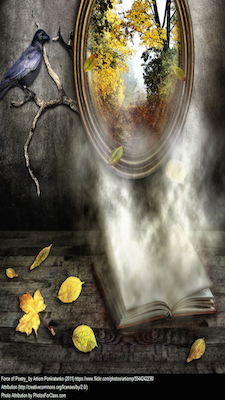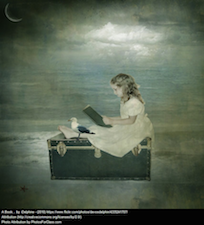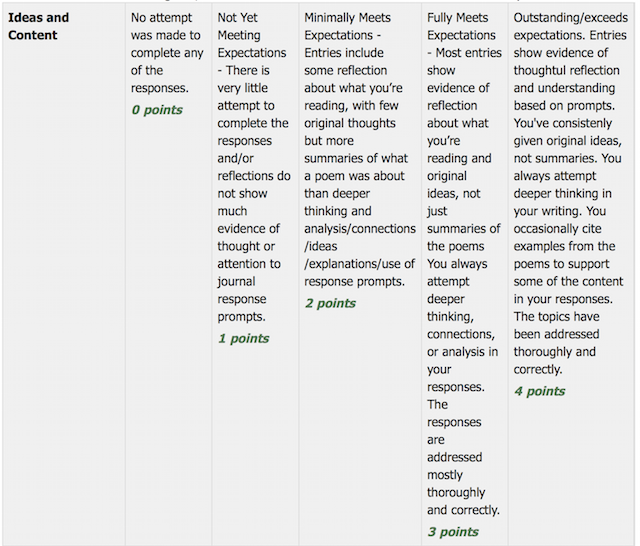4.1 Poetry Reading Journal
| Site: | Cowichan Valley School District - Moodle |
| Course: | ELA5, CSS, Sferrazza |
| Book: | 4.1 Poetry Reading Journal |
| Printed by: | Guest user |
| Date: | Tuesday, 16 December 2025, 3:03 AM |
Learning Targets
By the end of this unit, you should be able to say YES to the following questions. You will be working on this journal throughout this unit.
- Can I apply thinking skills to gain meaning from poems?
- Can I use personal experience and knowledge to connect to poetry and develop understanding of myself, my community, and the world?
- Can I read poetry as a source of creativity and joy?

Reading Poetry
Throughout this unit, you will read poetry - gobble up poetry - independently every day or two and complete responses in a "poetry reading journal". Where will you find these poems?
Go to the public library and to sign out some poetry books. There are also some online links below where you can find poetry. You have to be careful with websites, though, because they sometimes change. Ask your parent/home facilitator to join you when you explore links to websites outside this course, and be careful not to click on any advertising that may be added to these outside links.
Read poems and enjoy all their delicious parts - the juicy parts - the parts that make you wish for more!
Recommended books and websites include:
- Anything by Shel Silverstein including: Where the Sidewalk Ends, A Light in the Attic, Every Thing On It
- A Child’s Garden of Verses by Robert Louis Stevenson
- Anything by Jack Prelutsky, including: The New Kid on the Block, A Pizza the Size of the Sun, The Random House Book of Poetry, Something Big Has Been Here, Good Sports, The 20th Century Children's Poetry Treasury
- The Bridge Across the River by Shepherd Thorleif Halvorsen
- Love That Dog by Sharon Creech
- Monster Poems for Monstrous Kids by Melinda Kinsman
- Rainy Day Poems by James McDonald
- Joyful Noise: Poems for Two Voices by Paul Fleischman and illustrated by Eric Beddows (Poems to read with another person as a “duet”)
- Stopping By Woods on a Snowy Evening by Robert Frost and illustrated by Susan Jeffers
- Dark Emperor and Other Poems of the Night by Joyce Sidman
- Winter Eyes by Douglas Florian
- An Egret’s Day by Jane Yolen
- Classic Poetry: AN Illustrated Collection by Michael Rosen
- List of best children’s poetry books: https://www.goodreads.com/list/show/1340.Best_children_s_poetry_books
- Some poems by Jane Yolen: http://janeyolen.com/poetry/
- More poems - https://www.poetryfoundation.org/learn/children
Favourite Poems
Something to keep in mind as you complete this poetry journal - it will help you with an "end of unit" assignment. At the end of this unit, you will have the opportunity to present (audio or video recording, over the computer or phone) a "favourite poem". You will have choices about how you present it but all of the choices will include reading the poem and sharing some connections about why it is a good personal choice for you. Here is a video-based examples:
Reading Poetry Journal
 You will write regular journal entries based on poetry you are reading. Your entries aren't meant to be an essay! 5-10 sentences long is good.
You will write regular journal entries based on poetry you are reading. Your entries aren't meant to be an essay! 5-10 sentences long is good.
Here is a list of general sentence starters to use in responding to your daily independent poetry reading. DON'T USE THEM ALL IN ONE JOURNAL ENTRY! Pick one or two per journal entry. Use at least seven different prompts throughout your journal.
1. Describe an experience you (or someone else you know) had that the poem reminds you of.
2. Explain why you think the author wrote the poem.
3. What would you ask the author about the poem if you could?
4. Sketch an image that a poem you read brings to mind and explain why you chose to draw this scene. If you are completing your journal on a computer, you could scan your sketch into your journal or hand it in separately.
5. Describe a feeling or emotion that you experienced as you were reading your poems and what caused this feeling.
6. Write about a connection to another poem, book, or movie you have read. (Think of similar poems or themes. The poem, _____, reminds me of __________. I think this because ______________.)
7. Write down a quote or line that appeals to you. Describe why you like it or what you like about it.
8. Give your opinion of an author’s writing style. What images captured your interest? How did the author use rhythm, rhyme, or images to make their poetry better?
9. What is the overall emotional feeling (mood) of this poem? What words did the author use to cause you to believe this?
10. What two things did you like and/or dislike about a poem or poems you read? Explain why you think this way.
After you've written about the poems (or one poem) you've read, you can also write about other things you have been up to or other things about you. Feel free to ask your teacher questions, too, about reading or even something you would like to know about.
Where Do I Create My Journal?
How you create your poetry reading journal is up to you. Since it is a journal response to what you have read, you do not need to get really fancy. Your teacher is interested in your thoughts, which should be completed neatly and in full sentences, but you don't need to spend time on making your responses "pretty". Here are some ideas:
- Lined paper in a binder or duotang.
- On a word-processing (computer) document (.docx or .rtf available below).
- In a slideshow document (such as PowerPoint).
For each entry, put the date, your name, the title(s) of poem(s) you are responding to, and the author(s). If you wish, you can use one of the templates below:
How Will This Be Assessed?
Your teacher is looking for 8 or more entries and will mark your Poetry Reading Journal using a rubric:




